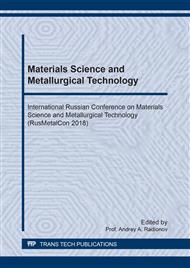[1]
M.V. Davydova, A.M. Mikhalev, Automated design systems (CAD) and product lifecycle support systems (SAP) in the specialized research laboratory CALS technology in engineering,, Bulletin of the Kurgan State University. Series: Engineering. 13 (2008).
Google Scholar
[2]
V.V. Shishkin, V.M. Kandaulov, The system of automated design of complex machine-building products on the basis of design patterns, Automation of management processes. 3 (2011).
Google Scholar
[3]
A.V. Rybakov, S.A. Evdokimov, A.A. Krasnov, A.V. Rybakov, S.A. Evdokimov, A.A. Krasnov, Creation of systems of automated support of information solutions for the design of technological equipment: Monograph, Izd-vo STANKIN Publishing house, Moscow, (2013).
DOI: 10.21685/2072-3059-2016-4-14
Google Scholar
[4]
A.O. Sazonova, A.A. Drozdov, Classification and location of CAM systems in automated design systems, Master's J. 2 (2014).
Google Scholar
[5]
G.B. Egenev, Ontological methodology of building intellectual systems in machine-building, News of higher educational institutions. Mechanical engineering. 6 (2014).
Google Scholar
[6]
Y.S. Lee, S.U. Lee, C.J. Van Tyne, B.D. Joo, Y.H. Moon, Internal void closure during the forging of large cast ingots using a simulation approach, J. Mater. Process. Technol. 211(6) (2011) 1136-1145.
DOI: 10.1016/j.jmatprotec.2011.01.017
Google Scholar
[7]
Y.Z. Liu, G.M. Cui, J.M. Zeng, W.K. Gan, J.B. Lu, Prediction and prevention of distortion for the thin-walled aluminum investment casting, Adv. Mater. Res. 915-916 (2014) 1049-1053.
DOI: 10.4028/www.scientific.net/amr.915-916.1049
Google Scholar
[8]
V.A. Pashnyov, D.Yu. Pimenov, Stress analysis of a three-layer metal composite system of bearing assemblies during grinding, Mech. Compos. Mater. 51(1) (2015) 109-128.
DOI: 10.1007/s11029-015-9478-7
Google Scholar
[9]
I.N. Erdakov, V.A. Ivanov, V.A. Pashnyov, P.V. Fekolin, Davydov, R. Walter, D.Yu. Pimenov, Studies of highly filled composite based on two-component organic binder stress state in thermal stress, Procedia Manuf. 22 (2018) 325–330.
DOI: 10.1016/j.promfg.2018.03.049
Google Scholar
[10]
A.D. Abdullin, New capabilities of software package ProCAST 2011 for modeling foundry operations, Metallurgist. 56 (2012) 323–328.
DOI: 10.1007/s11015-012-9578-8
Google Scholar
[11]
Yang, Z., Han, J., Cui, S., Kang, S.-B., Lee, J.-M. Solidification simulation of a SiCp/Al disk brake casting, J. of Ceramic Processing Research. 7 (2006) 363-366.
Google Scholar
[12]
J. Zhang, Z.-J. He, K.-R. Zhang, C.-M. Hu, F.-J. Zhang, L. Xi, Technique and numerical simulation of investment casting for TiB2/A356 diversion impeller, Zhuzao/Foundry. 64 (2015) 636-638.
Google Scholar
[13]
D. Broek ,The Practical Use of Fracture Mechanics, Kluwer Academic.
Google Scholar
[14]
A.N. Boldin, N.I. Davydov, S.S. Zhukovsky et al., Foundry molding materials. Forming, rod mixtures and coatings, Mechanical Engineering, Moscow, (2006).
Google Scholar
[15]
Materials strength with the fundamentals of the theory of elasticity and plasticity, G.S. Vardanian (Eds.), ASV Publishing House, Moscow, (1995).
Google Scholar
[16]
K.I. Emelyanov, V.M. Golod, Prediction of microstructural heterogeneity based on the coalescence model of dendritic branches, Proceed. of the best scientific-practical paper. Conf, Polytechnic University's Publishing house, Saint-Petersburg, (2014).
Google Scholar
[17]
I.N. Erdakov, R.F. Certificate of state registration of the computer program №2014610197. (2014).
Google Scholar


